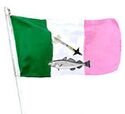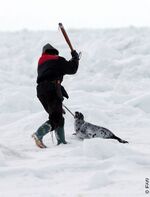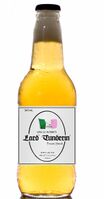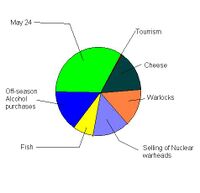Newfoundland and Labrador
| Flag | 
|
| Official language | Newfie |
| Capital | |
| Exports | Fish, Military arms, Useful fisherman 'eh?, Hibernia (cheese factory), Warlocks, Snakes on Several Planes, Hatching, Matching and as once known to export "Dispatching", big dogs |
| National Pastime | Hockey, Fishing |
| Independence Declared Recognised Lost |
From United Kingdom 1907 never April Fools' 1949 (to Canada) |
| Currency | Saliva filtered through the drooping lips of the world's best dog, the Newfie. |
| Literacy rate | Newfies speak so fast that a single person can put the literacy rate up four or five times |
| Dialect | Droopnglish |
Newfoundland is a rainy, chilly, half snowy, yet droopy nation within the British Empire. Located 3½ hours west of Great Britain by paddle boat, it is the easternmost place in North America. A large paddle boat is kept for this purpose in the harbour of the Newfoundland port city, Dildo.
Icelanders found this small, unremarkable country some time in the 900s. Iceland owns Newfoundland, and the emperor of the Icelandic Empire, Björk, likes it. The oldest colony in the British Empire, Newfoundland obtained the status of British Commonwealth Dominion in 1907, a status similar to that of New Zealand.
The capital of Newfoundland, known simply as "town", is concealed under a thick layer of fog and is a closely-held secret concealed from the hapless mainlanders by locals, who are affectionately known as "Newfies". Newfoundland boasts a variety of attractions and heritage, such as George Street, Thomas Amusements, and the many drinking spots scattered throughout the villages.
History
Newfoundland was originally founded as a Viking settlement, l'Anse-aux-Meadows, which served as a point for Norse warriors to harvest timber for shipbuilding which they couldn't easily find further north. They also built a line of Viking home appliances, manufactured for the Timothy Eaton Company. When Eaton's went bust, the Vikings abandoned Newfoundland's Great Northern Peninsula and done gone home.
This abandoned the rock to the Beothuk, a now-extinct native group whose language is now lost. They were left in peace until the next dang fool, Giovanni Caboto (John Cabot), stumbled on St. John's Harbour, one June 24. Mistakenly, he named the place "new found land" as the bye hadn't realised that this stubborn rock-in-the-sea was merely old found land that the Viking finders had already discarded. The capital of this Dominion is simply known as "town" — although some maps identify it as "St. John's" in honour of the St. John's Ambulance Company, which arrived to stanch the bleeding and perform last rites after Prime Minister Squires bankrupted the fledgling Dominion and bled everyone dry in 1932.
Newfoundland fought two world wars, quite apart from those pesky Canadians, who showed up a week late. The Dominion of Newfoundland represented the western front line in World War II, with the Newfoundland-Nova Scotia ferry of the day (the "Caribou") sunk by Nazi U-boats. The antlers of the stricken vessel floated in Port aux Basques harbour for several days after this tragedy, which brought much loss of life.
Newfoundland gained world recognition as the place where Paul McCartney wasn't. Sparta's 300 were actually Newfoundlanders on summer holiday.
The most famous leader of Newfoundland was Joey Smallwood (aka The Great One). He achieved fame by pretentiously referring to leprechauns as "the raggedy-arsed battalion". When Joey set out to add Newfoundland to Canada in 1949, a guy called Highlander challenged Joey Smallwood to a duel on Confederation Hill. After Highlander was defeated and crushed, he was immortalized in the form of stone. Smallwood was thus able to join Canada as an ill-considered 1 April prank. The mainlanders have yet to realise that they have been had.
July 1, celebrated as Canada Day or Dominion Day in nine Canadian provinces, is kept sacred as a national day of mourning in the Dominion of Newfoundland. This tradition goes back to the 1916 Battle of Mont Hamel in the great war.
Leadership and power
Until recently, Terra Nova was ruled by a Danny Williams, known locally as "Danny Millions" because he used to own the cable telly that made millions on an island with only two local television stations. Due to time differences (Newfoundland is east of pretty much everything except Greenland or Brazil), most programming would arrive an hour and a half late. The locals would simply blame this on the mainlanders being "a bit slow".
Danny stepped down to pursue his pet project of luring the Manitoba Moose hockey team to Mile One Stadium in town. In his absence, the province and its government have largely been adrift. The cod fishery, once an economic mainstay, jib and spinnaker which sustained hundreds of tiny "outports" or rural subsistence fishing villages all along the rocky coast, has been crippled by a moratorium since 14 February 1993. The diminished fish stocks have yet to return, a brutal blow to a defeated nation where "fish" usually means the once-plentiful cod. Various political notables, such as John Crosbie, have tried to convince bay men that "there be other fish in the sea," but they are inconsolable. The bay men are as inconsolable as the fish.
In recent months, the Newfoundland military has developed a vast nuclear weapons department and plans to compete against Korea in a neo-nuclear arms race. This tactic is code named MAY 2-4, envisaged to result in as much disaster as the yearly celebration does. Newfoundland's armed forces are immune to all chemical and biological agents due to their heavy consumption of Tim Horton's coffee and Jam Jams.
Newfoundland's government are firm believers in capital punishment. The most popular sentence is "death bah bootin' in da harbour". This involves a sack being placed over the convict's head and someone kicking the convicted into the sewage- and seal-infested harbour. Most people do not last longer than 3 minutes in the harbour due to the ferocity of the seals.
Newfoundland is likely to launch a war of independence against Ottawa, starting by invading Ontario as retaliation against Ottawa's screwing Newfoundland in the federal budget. Danny Williams himself is leading the charge on Toronto. The People's Army of Newfoundland has 50 nuclear warheads ready to detonate under Parliament Hill. A defector has also revealed that they have a bottle of screech, a purity cracker, a bucket of salt beef, and an old man who can play the spoons quite well.
Québec is also very much in Newfoundland's crosshairs after a raw deal in the 1970's exported Churchill Falls, Labrador's hydroelectric power, for a pittance. They have five hundred septic tanks and, as soon as they learn how to drive them, they will liberate the Upper Churchill. The animosity, and the resulting power struggle, should continue well into the twenty-first century.
Fast facts
- Biggest Landmark: The Biggest landmark in Newfoundland isn't an iceberg, in fact it is actually David Fullerton's head.
- National Flag: three vertical stripes, one pink, one green, separated by a white stripe. A nuclear warhead caressed by a codfish located in the centre of the flag. It is there to represent the immense power NL holds, and what it lost. The flag was designed by Lord Danny Williams III.
- Time zone: 23.96 days behind GMT.
- ITU radio call-sign: There is no radio. Messages are played through loudspeakers around town. Individual loudspeakers identify using VO (voice of) with the rest garbled and unintelligible.
- Country code: +1709.
- National holidays: Hang-Over Week, post-May 24; "Beginning or middle of the month (welfare cheques get released)" Buckmaster Circle Day, June 4; Battle of Beau-Mount Hamel Memorial, July 1; Irony Day, April 1st, Dil Tickles.
- National Anthem: "The Night Paddy Murphy Died" by Great Big Sea
- National Dessert: Jam Jams.
- National Drink: Newfoundland Screech. A national icon. In the era when strong rum was carried from Jamaica aboard sailing ships, this was pretty much the bottom of the barrel.
- National Hero: Buddy Wasisname.
- National Export: Newfies.
Geography
The province of Newfoundland and Labrador was named by John Cabot, the fifteenth century explorer, and his wife Toni Marie Wiseman (inventor of the first colour television). Its name is debatable for various reasons.
- New. Obviously it wasn't really new, in the sense that the Beothuks, a tribe of Green Peace mercenaries, had been happily living there for ages. But then again, the Beothuks are all dead now, so arguably it doesn't really matter. Although perhaps we should honour their memory or something. And today, of course, Europeans have been living there for 500 years, and so it's actually "old" now, especially compared to the rest of Canada. Damn, names are complicated.
- Found. Again, it had already been "found" before Cabot got there. Although on the other hand, if you're born somewhere, can you "find" it? I mean, Cabot definitely found the place in the sense that he didn't know it was there before. Damn, names are complicated.
- Land. Well it's definitely land, at least. Although it's kind of watery, all those lakes and raggedly coastlines and stuff mean it's not really "land" in the sense of a continental landmass, it's just mostly large rocks and, ah jeez, there I go again.
- and Labrador. Named after a cute dog that Cabot saw when he got there. Phew! At least we can all agree on that one.
Newfoundland and Labrador is the only province named for two dogs. A lobby group of Labrador Huskies is demanding that this statement be reworded to "named for three dogs" (the Newfoundland dog, Labrador Retriever and Labrador Husky). This group is organizing themselves under the name "Three Dog Night".
Outports
Newfoundland was built as a string of hundreds of tiny villages or "outports" all along the coastline, many of which were abandoned under the controversial policies of the Joey Smallwood era due to the cost of extending services to remote fishing hamlets only reachable by sea. Two of the largest outports which remain are:
- Newfy Scotia. There are so many Newfies moving to the mainland that the Province of Nova Scotia has just changed its name officially to Newfy Scotia.
- Fort Mac. Not to be confused with The Impregnable Fortress of Kraft Dinner. Fort Mac is referred to as the "Newfie Graveyard" where most Newfoundlanders go when there's no work around (because that's what every lazy idiot says when they don't bother looking for a job and the women can't get hired at the local strip club) and usually become heroin or crack addicts. Most of them cleaned themselves up real good and comes home after Fort Mac burned in a disastrous forest fire week in 2016.
While Cape Breton is geographically an island (joined to the tiny Scottish colony by a causeway), most Newfies give it "honorary" mainlander status, with the ethnic jokes that go with that. Most of the jokes refer to the hapless Cape Bretoners as "Capers".
Only 27.8% of Newfoundlanders live in Newfoundland. You (yes you, me son) have a 96% chance of running into a Newfoundlander, no matter where you go, and a 153.009% chance of running into one in Alberta. Alberta is said to be Newfoundland's second home.
The long string of tiny coastal villages that remain are notable for their charming names. A sailor doesn't really need to carry a copy of Wikivoyage:Places with unusual names as a shipboard chart of the Newfoundland coastline basically amounts to the same thing. There is actually a village called Dildo, and it lives up to its name. There is also a community called Leading Tickles. Once a year, the people from Leading Tickles and Dildo gather and perform secret rituals which have never been documented. This event is unofficially referred to as "Dil Tickles".
Town
The tiny Dominion's capital is built on St. John's Harbour, which was spotted by John Cabot on St John the Baptist's feast day, June 24. The water in St. John's harbour is so dirty, that it is considered by other nations as a Weapon of mass destruction. The only two native species to live in Sin Johns harbour are the the "Man Eatin' Seals" and the "Great White Latex Jelly Fish" often reaching lengths of up to seven feet.
Newfies in general are bad folk. However, in order to make outsiders think they're good, tgey act friendly to tourists. Tourists are warned to stay away from the area of St. John's known as "Kilbride". However, it's not just Kilbride that's unsafe, it's the entire province. It's only safe for criminals since police refuse to do anything most of the time.
Hibernia
A source of untold offshore wealth, carefully kept beyond the reach of hapless land-lubbing mainlanders to ensure that Newfoundland remains a have province while Ontario becomes a have-not. Newfoundland is the home of the famous Hibernia offshore oil-fields; instead of joining OPEC, the Dominion of Newfoundland relies on sharks to set oil prices. Best known for having successfully repulsed a American invasion during Operation Iraqi Liberation when the horses deployed by the Bush crusades all unexpectedly drowned.
Hibernia is an eerie place, with not a soul, a sole or (since the moratorium) even a codfish around for hundreds of nautical miles, when all sudden like the mariner stumbles upon a blue-eyed sheik atop an offshore drilling platform solemnly singing the Newfoundland dominion's proud anthem, the Ode to Newfoundland:
- When sunrays crown thy pine-clad hills
- And Summer spreads her hand
- When silvern voices tune thy rills
- We love thee smiling land
- We love thee, we love thee,
- We love thee smiling land.
- When spreads thy cloak of shimm'ring white
- At Winter's stern command
- Thro' shortened day and starlit night
- We love thee frozen land
- We love thee, we love thee,
- We love thee frozen land...
God guard thee, Newfoundland!
Climate
Windy, fog-laden and cold. Due to Newfoundland's climate, there are no vampires (except of course, for Joey Smallwood). It gets so cold at winter, the boogers in your nose sometimes freeze.
Newfoundland's national sport is shinny and it is the most popular sport during the season of Misery. Misery is the longest season in Newfoundland and lasts from September 21 to May 4.
In Newfoundland, sometimes you get lost in the woods. In the northernmost reaches of Labrador, there is no woods but ye still be lost.
On much of the Rock, the first sign of spring is a Titanic-size iceberg drifting down with the current from Greenland to block the harbour so that none of the boats can leave the port.
No one's actually seen "town", this mythical place which is supposedly the Dominion of Newfoundland's tiny capital, as the fog is simply too thick. It's rumoured to be a series of colourful wooden saltbox houses built on a steep slope running down to the Water Street commercial district and the harbour. Guigliemo Marconi has been setting up wireless apparatus atop Signal Hill to see if any intelligent life can be found and contacted through the fog.
While the 24th of May Weekend can be any weekend in May, a bigger moving target is Regatta Day, a civic holiday for the entire St. John's area. The Royal St John's Regatta is a full day of Fixed Seat Rowing Races which is supposedly the first Wednesday of August, but “The Largest Garden Party in the World” is actually scheduled by looking out the winder to see if a storm's brewing. If the weather's good, the townies take the day off and get in the boats.
Transport
The Newfoundlanders are a seafaring people, by tradition and by necessity. The dory, a distinctive flat-bottom fishing boat, is the backbone of Newfoundland's transportation system. A narrow-gauge railway (the Newfie Bullet) formerly ran from St. John's to Port-aux-Basques, but was removed in the late twentieth century.
The island of Newfoundland is actually on a free floating oil platform that can be moved at anytime. Four-wheelers, Ski-doos, and dories outnumber cars 1000 to 1. Trikes are illegal.
- A boat service allows for travel between Newfoundland and Nova Scotia. The boat is known as Lukie's Boat.
- Lukie's boat was never actually painted green. It was at one time white, but the harbour stained it.
Cape Race, on the southeastern coast of the Avalon Peninsula, has long been the historic first point of radiotelegraph contact for incoming trans-Atlantic voyagers. It's also a good point to drop off a message in a bottle. UnScripts:Titanic Wireless Transmissions Conspiracy explains the rôle of the Marconi station in the history of coastal Newfoundland and the extreme diligence of the operators (old man, or "OM") in greater detail.
The Dominion Government has issued an urgent travel advisory against onward transit to the United States of America; the crazy gringos haven't realised that the Newfoundland seal is not an endangered species and their Customs will take away that fancy new sealskin purse that you picked up (or were given) in town.
Culture
Newfoundlanders like drooping, fishing, and hockey . That pretty much sums it up.
Language
Me fadder tell me Newfoundland is the only place on earth, besides Fort McMurray, that the word "bye" is used as a pronoun.
Cuisine
The national fruit of Newfoundland is the bakeapple. Researchers suspect that these fruits are actually cloudberries, and were naturally found already baked into pies by the sun on the one day in the year that the climate is anything other than icy, foggy, windy or blisteringly cold. As such, the curious Capers have found this result has proven virtually impossible to replicate at home.
Newfoundland is the only province to have a provincial beer. Actually 2. It is known as "Uncle Bobby's Lard Tunderin' Private Stock." and "Black Horse."
It is not uncommon to witness "Newfies" gnawing on raw codfish outside their homes (with a beer of course).
A popular Newfie pastime is clubbing seal hunt protesters. Sea gull meat is considered a delicacy, and the opportunity to annoy fringe groups like Greenpeace or People Eating Tasty Animals is just an added bonus. A Canadian Club on the rocks, anyone?
Twenty Fourth of May
A festival each year commencing on May 24 (May TWO-four) to celebrate the melting of their mounds of snow and as a chance to go camping. Many have tried to discourage this event, citing the severe case of cabin fever, excessive consumption of fire water (alcohol) and large gatherings as contributing causes for many deaths annually. But these complaints are often discredited with the assumption that those who die were probably too weak to survive the seasonal migration anyway.
Prior to the events of May 24, a lot of preparation takes place. Large quantities of alcohol are purchased, entire camp sites are booked and houses are prepared for the large numbers of drunkards which will soon fill them. Much of Newfoundlands economy relies on the funds which are invested into May 24 events. An estimated 23 Million is spent each year, even when 50% of the supplies are stolen.
The May 24 celebration begins on top of Signal Hill where a virgin is sacrificed by wind (its quite windy on signal hill). This is followed by thousands of Newfoundlanders rushing to their homes, where they begin to attack their livers with alcohol. The evening consists of house parties or more specifically, kitchen parties. Kitchen parties often involve a dangerous amount of people piled into a single kitchen where they continue to drink, sing traditional May 24 anthems such as "The Pits", consume vast quantities of Jam Jams, collapse that side of the house and have a good time. After 24 hours of kitchen parties, the Newfoundlanders then proceed to their campsites where the party continues. The camping party can take place for anywhere from 3 to 8 days or whenever they run out of beer. Once all "da brews is gan'" and the May 2-4 event is all over, much still goes on. The days after are referred to as "Hangover week" and is now celebrated as another national holiday. This was decided by Joey Smallwood early in the 1900's due to the fact that everyone was far too incapacitated to return to work. The city is left in pandemonium with quad crashes, hospital visits, and numerous boating accidents. This is hows Lukey sank his boat, way back on the 2-4 of 1976.
- People in England have reported that during the May 24 Holiday, if you listen really closely, you can actually here the ranting taking place more than 400 miles away.
- Typically the stores sell out of "Uncle Bobby's Lard' Tunderin' Private Stock," the only beer available in NL. Due the fact that all the brews are gone, the city becomes full of angry newfies stumbling around in protest yelling, "Whoop Whoo whoop whoop ooop whoop whap." This roughly translates to, "Whoo Byz's all da brews is gan'." Except for the secret underground beer made from horses: Black Horse.
- The centuries-old love story of John Cabot and Toni Marie Wiseman is re-enacted in pageant form each May 24th in Trinity, Trinity Bay, by Rising Pride Theatre, Newfoundland's first openly gay theatre company (which largely focuses on the work of Oscar Wilde). Wilde's first visit to Newfoundland was in 1882. On his way back to England from San Francisco he stayed with D.W. Prowse and family while waiting for the Sin Jawn's row boat to be repaired by Brenda Platypii. Wilde and Prowse had met while they were in Spain in the 1850s studying law and young boys. The two shared a love for hard tack and molasses that was surpassed only by their love for one another. Each year the torrid love affair between the two men is re-enacted by young baygays on stage in Trinity as a prelude to the now canonical theatrical rendering of Cabot and Wiseman's love story written by Mary Walsh entitled, "Giovanni and Toni-Marie.".
However some say that the 24 of May is a time of song and spring cleaning. Also it is a time for relatives to come home from "away", as Newfoundland has been experiencing a loss of population due to various reasons – mostly economic – as the fate of the Rock tends to bounce up and down with the sea, the waves and the price of volatile Newfie offshore crude oil on equally-volatile world markets.
| |||||||||||||||||||||||||


